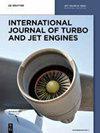Study on laser de-weight and dynamic balance technology of rotating machines
IF 0.9
4区 工程技术
Q4 ENGINEERING, AEROSPACE
引用次数: 0
Abstract
Abstract To solve the poor precision and low efficiency of manual grinding de-weight dynamic balance of turbopump rotor, the laser de-weight dynamic balance technology of rotating machines is adopted. Combined with the advantages of laser de-weight, such as, fast processing speed high machining precision and good machined surface quality, the smooth transition of the machined surface was realized by means of hierarchical machining. According to the characteristics of the turbopump rotor structure, the equivalent transformation model for laser de-weight turbopump rotor was built to convert the unbalance into laser processing parameters, which achieve the rapid and accurate de-weight of turbopump rotor. It focuses on solving the repeatedly loading and low accuracy of manual grinding dynamic balance. To verify the effectiveness of the proposed technique, laser de-weight experiments were carried out on two turbopump rotor test pieces. A dynamic balance test bench was set up to measure the rotor residual unbalance at 1800 r/min test speed, which is low dynamic balance. The results show that the machined surface transition was smooth, the residual unbalance was small and the machining efficiency was high. The effect of laser de-weight dynamic balance reached the expectation. It is an universal technology which is not limited to the dynamic balance of turbopump rotor, but also applicable to other rotating machinery..旋转机械激光失重及动平衡技术研究
摘要为解决涡轮泵转子手工磨削减重动平衡精度差、效率低的问题,采用旋转机械激光减重动平衡技术。结合激光减重加工速度快、加工精度高、加工表面质量好等优点,采用分层加工的方法实现了加工表面的平滑过渡。根据涡轮泵转子的结构特点,建立了激光减重涡轮泵转子的等效转换模型,将转子的不平衡转化为激光加工参数,实现了涡轮泵转子的快速、准确减重。重点解决了手动磨削动平衡的重复加载和精度低的问题。为了验证该技术的有效性,对两个涡轮泵转子试件进行了激光减重实验。建立了动平衡试验台,在试验转速为1800 r/min时测量转子残余不平衡,属于低动平衡。结果表明:加工表面过渡平滑,残余不平衡小,加工效率高。激光减重动平衡效果达到预期。它是一项通用技术,不仅局限于涡轮泵转子的动平衡,也适用于其他旋转机械。
本文章由计算机程序翻译,如有差异,请以英文原文为准。
求助全文
约1分钟内获得全文
求助全文
来源期刊

International Journal of Turbo & Jet-Engines
工程技术-工程:宇航
CiteScore
1.90
自引率
11.10%
发文量
36
审稿时长
6 months
期刊介绍:
The Main aim and scope of this Journal is to help improve each separate components R&D and superimpose separated results to get integrated systems by striving to reach the overall advanced design and benefits by integrating: (a) Physics, Aero, and Stealth Thermodynamics in simulations by flying unmanned or manned prototypes supported by integrated Computer Simulations based on: (b) Component R&D of: (i) Turbo and Jet-Engines, (ii) Airframe, (iii) Helmet-Aiming-Systems and Ammunition based on: (c) Anticipated New Programs Missions based on (d) IMPROVED RELIABILITY, DURABILITY, ECONOMICS, TACTICS, STRATEGIES and EDUCATION in both the civil and military domains of Turbo and Jet Engines.
The International Journal of Turbo & Jet Engines is devoted to cutting edge research in theory and design of propagation of jet aircraft. It serves as an international publication organ for new ideas, insights and results from industry and academic research on thermodynamics, combustion, behavior of related materials at high temperatures, turbine and engine design, thrust vectoring and flight control as well as energy and environmental issues.
 求助内容:
求助内容: 应助结果提醒方式:
应助结果提醒方式:


